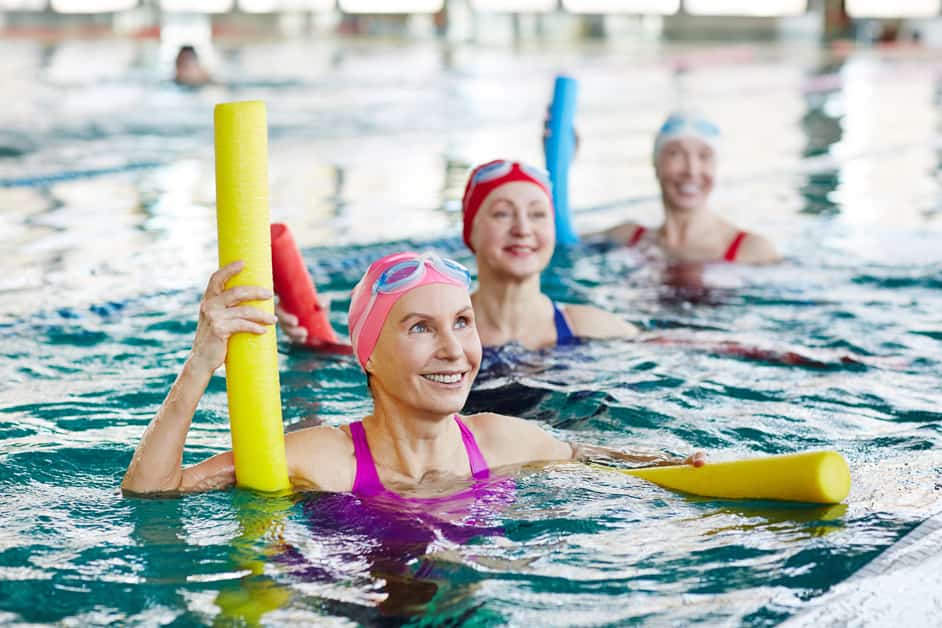Introduction
Did you know that water aerobics is a great low-impact exercise for knee rehabilitation? It is non-weight bearing and the movements are gentle on the joints. It can help improve mobility and strength. Plus, it can increase your cardiovascular endurance and overall fitness.
This article will discuss all the benefits of water aerobics. We will also share the basics and tips on how to do it safely and effectively.
Benefits of Water Aerobics
Water aerobics is an exercise done in a pool. It is useful for both physical therapy and general conditioning. The buoyancy of water reduces the effect of gravity on your joints, making it a low-impact exercise.
It provides the same intensity and challenge as land-based exercises.
Water aerobics has benefits for those rehabilitating an injury or trying to improve their fitness levels. Buoyancy and resistance in the water give natural support for each exercise. It also helps spread weight evenly across the body, making it suitable for those with limited mobility and special needs.
Water aerobics can reduce stress and improve sleep patterns, due to its calming environment. It increases oxygen flow throughout the body, making it useful for cardiovascular fitness and fertility rates. Finally, it can be done at any age, even by those recovering from surgery or medical conditions!
Types of Water Aerobics
Water aerobics is a gentle workout. It’s great for people with knee injuries or other physical issues. You do this kind of exercise in a pool. The water helps strengthen the muscles around the knee.
There are various types of water aerobics you can use to recover from a knee injury. Let’s find out more about them and their advantages:
Low Impact
Low-impact water aerobics exercises use the water’s resistance. This helps you work out without causing jarring movements or overexertion. It is beneficial to those with joint problems such as knee injuries, arthritis, and impaired mobility. Examples of low-impact exercises include:
- Aquatic walking – Walking with gentle ankle rotation in shallow water. This helps build endurance and strength in the legs.
- Slow jogging – Jogging without leaving the pool floor. This minimizes impact on joints and builds cardiovascular endurance.
- Resistance/Strength training – Use small handheld equipment such as dumbbells, noodles, or webbed gloves. Helps increase muscle strength and balance.
- Knee stretches – Improve knee range of motion and flexibility by slowly moving the joint through pain-free ranges of motion.
- Kickboxing – An energizing twist on traditional aerobics. Overall body workout with intense cardio. Moves through various martial arts forms. Adds simple choreography sections creating a fun and effective workout in shallow water.
High Impact
Want a more intense water workout? High-impact aerobics are perfect! Your body is pushed against the water with more force, helping tone and build muscle. Exercises can include running, jumping jacks, and lunges.
Equipment such as resistance bands or aquatic dumbbells can be used for a full-body workout. This type of activity requires more endurance and coordination than low impact exercises. It’s also beneficial for people recovering from knee rehabilitation.
Knee Rehabilitation
Knee rehab? A must! To rebuild the strength in the muscles, ligaments, and tendons around the knee joint, exercise is key. Water aerobics is a great choice! Low impact, it can be tailored to your physical abilities. Perfect for knee issues. Let’s explore the benefits of water aerobics for knee rehab!
Strengthening
Strength training is crucial for knee rehabilitation. However, gyms can be expensive and intimidating. Water aerobics classes are an awesome alternative! They are easy to find, require minimal equipment, and provide a low-impact environment that protects the injured knee joint.
Besides, water aerobics classes offer companionship. Participants often chat while working out, making it more enjoyable. Plus, it’s easier to reach goals when you have someone else pushing you!
Water aerobic exercises can help people increase their fitness levels. They usually start with warmup exercises that prepare the muscles and joints. After that,
- leg lifts,
- kicks,
- squats,
- and lunges
are done to strengthen the muscles around the knee joint. It’s important to do the exercises correctly to avoid re-injury. People with severe arthritis or chronic conditions should consult with a physical therapist or doctor before attempting these exercises.
Stretching
Stretching is great for a workout routine and especially helpful for knee rehab. When possible, stretch before and after exercising. Here are some beneficial stretches for the knees:
- Wall Sits: Lean on a wall. Slide down until your thighs are parallel to the floor. Hold 10-15 seconds. Stand up and repeat 5 times.
- Quadriceps Stretch: Stand with one foot in front of the other. Bend the front leg and keep back straight. Rest your hands on your knee for balance if needed. Hold 15-30 seconds. Switch legs and repeat.
- Hamstring Stretch: Sit on the floor. Extend one leg and keep the other bent. Lean forward from the hips towards your extended foot. Use a towel or yoga strap if needed. Hold 15-30 seconds. Change legs and repeat.
- Calf Stretch: Stand with both feet together. Step one foot backward. Rise onto tip toes and bend knees slightly until you feel a pull in the calves. Hold 10-20 seconds. Switch legs and repeat.
Range of Motion
It is essential for those healing from knee injuries or surgeries to keep their knee supple and extend the range of motion. Water aerobics is a secure choice that can promote healthy recovery. The buoyancy offered by the water can reduce compression and shear forces on the joint, as well as provide enough resistance to motivate movement. As a form of exercise, water aerobics offers low impact activity with little risk to guarantee raised knee mobility.
Range-of-motion exercises are crafted to maintain, renew and refine the huge group of muscles and small ligaments around the knee joint, leading to better joint function over time. Exercises like leg extensions and leg lifts are generally used as range-of-motion exercises after an injury or surgery because they require both flexion and extension in particular movements, while helping to decrease pain or inflammation in weak or damaged areas.
When blended with regular stretching and other strength-building techniques, for instance, using elastic bands around the thighs for enhanced muscle performance, range-of-motion exercises become a vital part of any comprehensive physical therapy program focused on reinforcing strength around your knees. Water aerobics provides you the pleasure while you do these movements, which would be difficult on land because of increased body weight bearing upon impact with each activity. Thus, it’s an excellent way for people after an injury or surgery to facilitate improved movement in their ankle and lower leg, avoiding any further damage during rehabilitation efforts due to its low impact nature.
Safety Considerations
Water aerobics is an exercise with low impact. It is suggested for people with knee or joint troubles. Before doing this type of rehab, one must think about safety risks connected with it. Here are some safety considerations to keep in mind:
- Ensure the pool is clean and free of debris.
- Check the temperature of the pool before entering.
- Be aware of the depth of the pool.
- Always exercise with a partner.
- Wear the appropriate footwear.
- Be aware of the pool rules.
Listen to your body
Always listen to your body’s safety warnings! If your muscles or joints ache, rest up before continuing to work out. Stretching can help ease muscle tension and improve flexibility. Massage can improve circulation and reduce strain.
Stay hydrated! Have 8 ounces of water for every 20 minutes of exercise. If you’re doing intense workouts, add electrolytes like sodium or potassium to replace lost minerals.
Wear the right gear: shoes with arch support and cushioning; clothing that absorbs sweat fast. Watch out for any existing conditions or injuries – don’t risk re-injury by overdoing it!
Wear proper equipment
It’s essential to wear the right safety gear when working or doing any potentially hazardous activity. This is especially true in industrial settings, where the right attire can help protect you from minor or serious injury.
For instance, before entering a construction or factory, workers must wear protective clothing such as long pants and shirts, steel-toed boots, and recommended eye and head protection. In some cases, additional safety gear may be necessary; e.g. if working with dangerous materials like lead or asbestos, a hazmat suit is needed. It’s also vital to assess the environment, as workplaces may have extreme temperatures that require insulated garments.
Taking proper precautions by wearing the right equipment can reduce the risk of an accident – never enter a risky area without it!
Follow instructor instructions
When doing water aerobics, it’s important to follow the instructor’s instructions. Ask any questions before you start. Some moves might not be right for your level, so the instructor will help you adjust.
Be mindful of your environment. Make sure the pool is clear of obstacles and not too crowded. If it is, just do what you can safely and comfortably manage.
If you’re not sure about a move, ask for help. It’s better to stay safe than try something that’s too hard for you, especially if you are doing water aerobics for knee rehabilitation.
Conclusion
Finally, water aerobics is super for those who have had a knee injury or surgery. The water supports the body, taking away pressure from the joints. Plus, the resistance of the water helps the muscles get stronger and the balance improves. It can also make the joints more flexible and reduce pain and swelling.
In other words, water aerobics can be a great way to rehab a knee injury.
Summary of Benefits
Water aerobics is a brilliant, low-impact exercise. It helps to improve strength and stability in the lower body. Plus, the water environment also offers support for those with painful injuries. As it’s gentle on the knees, it helps to keep flexibility during rehabilitation.
Moreover, it’s great for fitness. It increases cardiovascular fitness and helps to burn calories. And it can be adapted to any ability level – alone or with a group. Therefore, water aerobics is a great choice for those looking for a supportive form of exercise to improve joint function and lessen strain on sore areas.
Frequently Asked Questions
Q1: What is water aerobics?
A1: Water aerobics is a type of aquatic exercise that uses the natural resistance of water to provide a low-impact workout. It can include activities such as water walking, swimming, and jumping, as well as using tools such as water weights and noodles.
Q2: What are the benefits of water aerobics?
A2: Water aerobics provides a low-impact workout that is easy on the joints and muscles. It is also beneficial for knee rehabilitation, as the water’s resistance helps to build strength and endurance and can reduce swelling and inflammation.
Q3: Are there any risks associated with water aerobics?
A3: Water aerobics is generally a very safe exercise option, but it is important to take any necessary safety precautions such as using a life jacket or pool noodle and exercising in an area that is supervised by an instructor or lifeguard.





